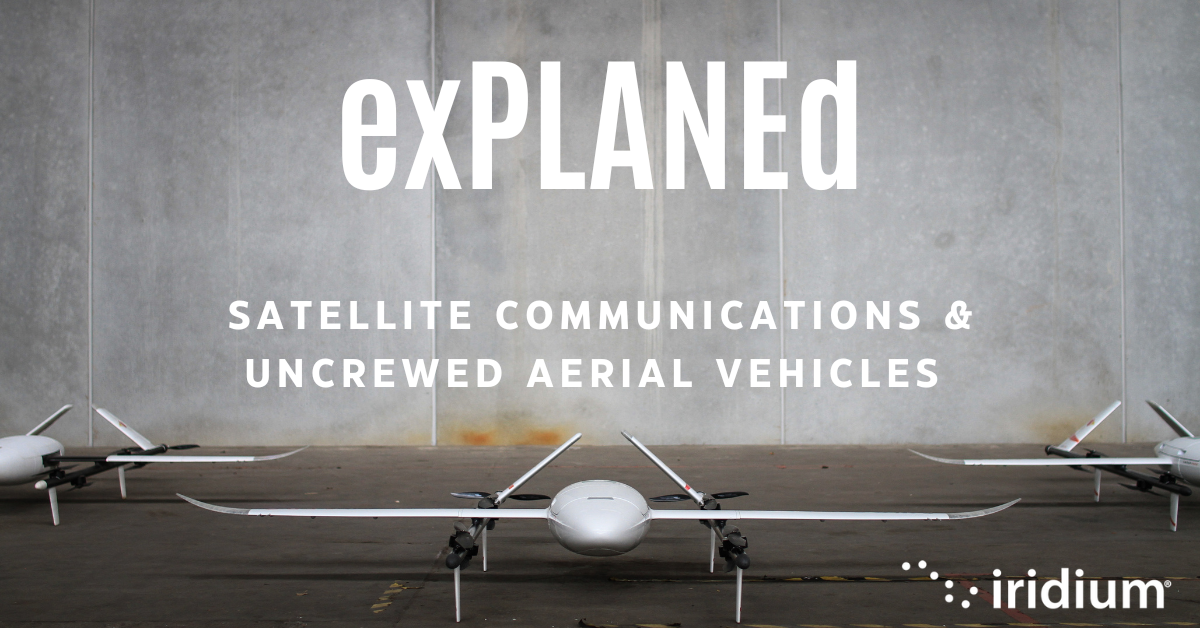Satellite Communications & UAVs

The global Uncrewed Aerial Vehicle (UAV) market is expected to reach $70.91 billion by 2030. This projected growth reflects the huge potential of UAVs beyond hobbyists and government applications. In this edition of exPLANEd, we explain what UAVs are, how and why they are used, review their specific set of communications needs and how Iridium® satellite communications (SATCOM) is helping to make UAV flight possible and successful.
What Are UAVs & Why Are They Used?
Uncrewed Aerial Vehicles (UAVs) are just that: vehicles operating in the air without a crew on board. They are used for missions that require flight to areas too dangerous or not ideal for flying a crewed aircraft. Examples of these areas and use cases include remote inspections (think remote pipelines, rail and power line monitoring), disaster recovery and surveillance efforts, environmental monitoring in uncharted territories and more.
Piloting remote aircraft, especially Beyond Visual Line of Sight (BVLOS), meaning the pilot is responsible for operating the aircraft even when it is no longer in their view, comes with a specific set of communications requirements. UAV pilots must be able to make critical, split-second Command-and-Control (C2) decisions mid-flight–such as rerouting a mission due to unexpected weather patterns and air traffic. They also need access to a constant flow of critical data, including but not limited to navigational, weather and aircraft health information. Most importantly, these pilots need to know that no matter where they are required to fly their aircraft, they will have access to fast, reliable connectivity, and Iridium Connected™ technologies are uniquely qualified to support these needs.
How Iridium Benefits The UAV Market
Global Line of Sight®
Iridium operates the only truly global satellite network. Its crosslinked constellation of Low Earth Orbit (LEO) satellites creates a web of coverage around the entire planet, including locations that lack connectivity, like the Arctic. This is ideal for UAVs because no matter where they fly, a pilot can control and observe the aircraft regardless of how far away the vehicle is. With Iridium, BVLOS C2 is a specialty. Also, because of the network’s location in LEO, it delivers low-latency connectivity that makes near real-time data delivery possible, which is essential for these aircraft.
Highly Reliable Satellite Connectivity
In addition to enabling truly global coverage, Iridium’s connectivity is delivered over weather resilient L-band satellite spectrum, making it ideal for delivering critical communications solutions, such as connectivity for UAVs. For remote pilots, safety is the top priority, and there is no larger threat to flight safety than unpredictable weather patterns. For example, if a sudden storm passes through and a pilot needs to change flight plans–taking the aircraft BVLOS to avoid dangerous conditions–Iridium technology is a must-have.
Highly Accessible and Flexible
Iridium has a vast partner network of over 450 companies around the world, making Iridium technology very accessible. While Iridium technology is perfect as a primary communications system on board a UAV, it can also act as a backup to traditional line-of-sight or cellular technologies, kicking in for BVLOS and C2 needs.
Today, Iridium is connecting UAVs around the world and across multiple industries. For instance, UAV company Swoop Aero integrated Iridium technology into its drones’ C2 systems to deliver critical medical supplies on the island nation of Vanuatu, where access to life-saving treatments is limited due to its lack of infrastructure and remote location. In collaboration with UNICEF and Vanuatu’s Ministry of Health, Swoop Aero created an on-demand vaccine delivery program that quickly brings vaccines to local nurses and healthcare workers in temperature-controlled packaging, ensuring the safe delivery and administration of vaccines to the population. This is just one of many examples of how Iridium is enabling innovative applications for the fast-growing UAV market.

